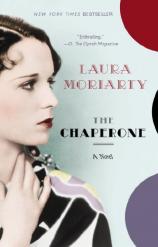The Chaperone
Review
The Chaperone
Laura Moriarty is strongly affiliated with her home state of Kansas, where she teaches at the University of Kansas in Lawrence. She's also strongly associated with contemporary fiction about women's concerns, especially pertaining to the relationships between mothers and daughters. So it's not entirely surprising that, although her new novel is certainly a departure from the more contemporary settings of her other books, she still focuses on an historical figure with her own strong Kansas roots: the dancer and actress Louise Brooks.
"THE CHAPERONE is a fascinating portrait not only of a famous historical figure too little known these days, but also of the equally compelling 'ordinary' woman who Moriarty imagines at her side."
For those of you unfamiliar with Brooks, try doing a Google image search of her; you may recognize her (or at least her hairdo) in spite of yourself. In many ways, Brooks was the quintessential flapper, with her blunt cut bob haircut and short bangs, athletic figure and sassy expression. But before she was starring in silent films with the likes of W.C. Fields, Brooks was a Midwestern girl from Kansas. The moment at which 15-year-old Brooks travels East to New York in the summer of 1921 to find her fortune with the Denishawn modern dance company is the moment on which Moriarty chooses to focus her novel.
But, as its title suggests, THE CHAPERONE is no mere imagining of a famous person's life; instead, Moriarty's primary focus is on Cora Carlisle, Louise's older chaperone, who has her own secrets and her own reasons for wanting to visit New York. Unbeknownst to virtually everyone but her husband, Cora spent her early years in New York City, in a home for "friendless girls" on the Lower East Side, before being sent out West on an orphan train and finding a loving home with the Kaufmans, a stoic but kind Kansas farm couple. Cora is as intent on finding her roots as she is on preserving Louise's virtue.
In these two women, Moriarty effectively captures the social and sexual tensions of the day. Cora is shocked by Louise's forward behavior even as she harbors her own sexual secrets and contemplates new possibilities. She is scandalized by the young woman's revealing outfits and facial cosmetics even as she grows frustrated and short of breath, confined by her corset. The book’s irony is that Cora, terrified of the big city corrupting her impressionable young charge, might be the impressionable one of the pair. Certainly both Louise and Cora will come away from their summer transformed.
At times, Moriarty seems to let the weight of history get the better of her, as the prose pulls away from the action to discuss the larger importance of what Cora witnesses (a scene at a performance of the musical Shuffle Along is a good example). These kinds of historical and social commentaries on the part of the narrator effectively pull the reader out of the story, which is quite compelling in its own right. Overall, THE CHAPERONE is a fascinating portrait not only of a famous historical figure too little known these days, but also of the equally compelling "ordinary" woman who Moriarty imagines at her side.
Reviewed by Norah Piehl on June 8, 2012
The Chaperone
- Publication Date: June 4, 2013
- Genres: Fiction, Historical Fiction
- Paperback: 416 pages
- Publisher: Riverhead Trade
- ISBN-10: 1594631433
- ISBN-13: 9781594631436





